Learn about the city’s new proposed bike infrastructure improvements and what it means for you.
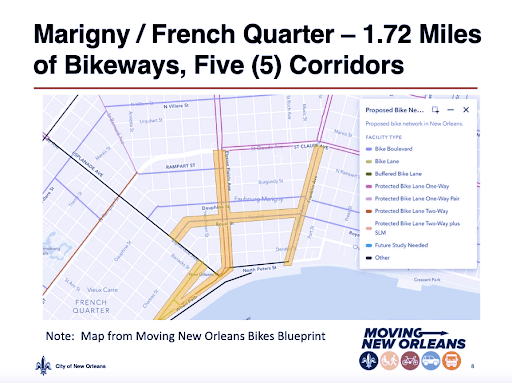
There’s a lot to be excited about with the upcoming improvements to New Orleans’s streets.
But what exactly are the new bike infrastructure improvements? How do they make our streets safer and more enjoyable for everyone? And do we properly use them to keep ourselves and others safe and focused on enjoying the ride?
Let’s take a closer look at some of the new proposed bike infrastructure elements and how to make use of them so we can make our streets safer for everyone.
PROTECTED BIKE LANES
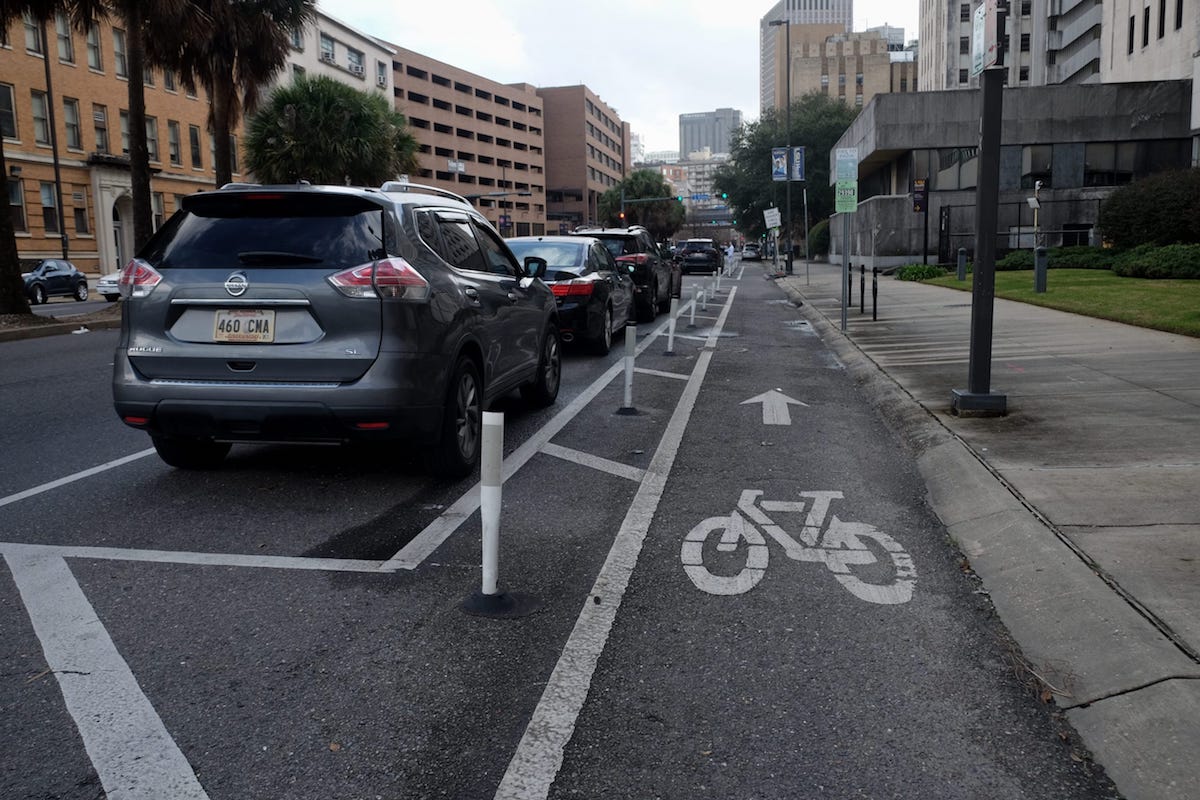
A parking-protected bike lane on Tulane Ave. puts parked cars between bike and car traffic to create separate designated spaces.
Protected bike lanes have a physical barrier between motor vehicle traffic and people on bikes. A 13-year study of a dozen cities found that protected bike lanes led to a drastic decline in fatalities for all users of the road. According to the National Association of City Transportation Officials (NACTO), benefits of these one-way protected lanes include:
- Dedicates and protects space for bicyclists in order to improve perceived comfort and safety.
- Eliminates risk and fear of collisions with over-taking vehicles.
- Reduces risk of ‘dooring’ compared to a bike lane and eliminates the risk of a doored bicyclist being run over by a motor vehicle.
- Prevents double-parking, unlike a bike lane.
- Low implementation cost by making use of existing pavement and drainage and by using parking lane as a barrier.
- More attractive for bicyclists of all levels and ages.
What do parking-protected bike lanes mean for you?
When biking:
- Roll in comfort with more safety and less stress in between the curb and parked cars.
- Watch for debris! While we’re pushing for solid maintenance of these lanes, they still sometimes collect branches, rocks, etc more quickly, so make sure to look out!
- Share the lane with pedestrians and people in wheelchairs. Just like in the road, people will be crossing the lane and sometimes they’ll wander off the sidewalk. Moreover, we think bike lanes can be an easier, more accessible place for people with disabilities to roll, and we love sharing the space!
When driving:
- Roll in comfort with more safety and less stress with more clarity about where you and the people biking each have space.
- Don’t drive or park in the bike lane! When parking, just pull up on the left side of the posts and park. People will still be able to easily bike by between you and the curb, so look both ways in the bike lane before crossing.
- Be careful at intersections. Even with parking-protected bike lanes, people driving and people biking still mix, especially at intersections. Stay aware and slow down through intersections and especially when making turns.
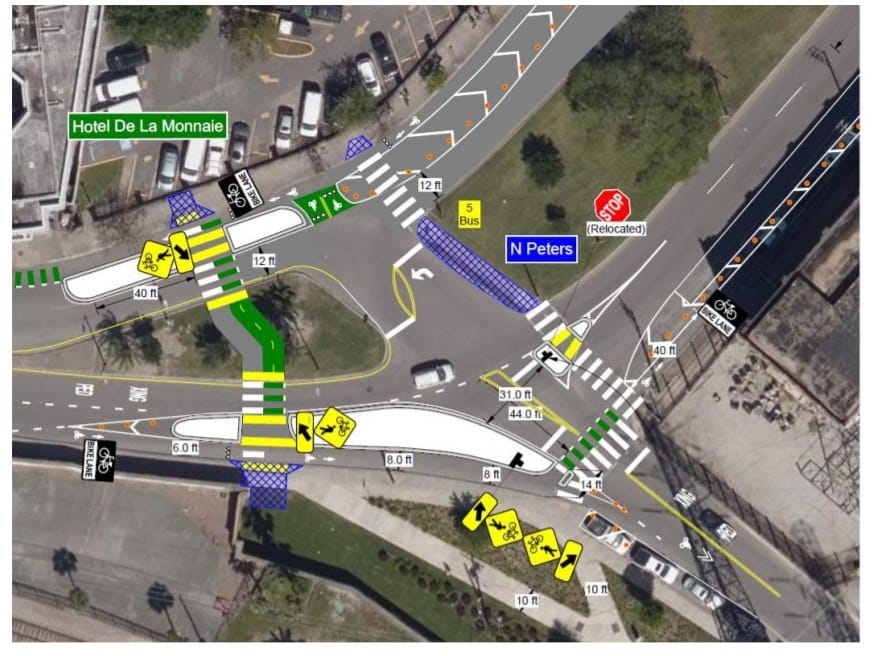
Parking-protected bike lanes, islands, improved stormwater drainage, and marked crosswalks are planned for Elysian Fields Ave and N. Peters St.
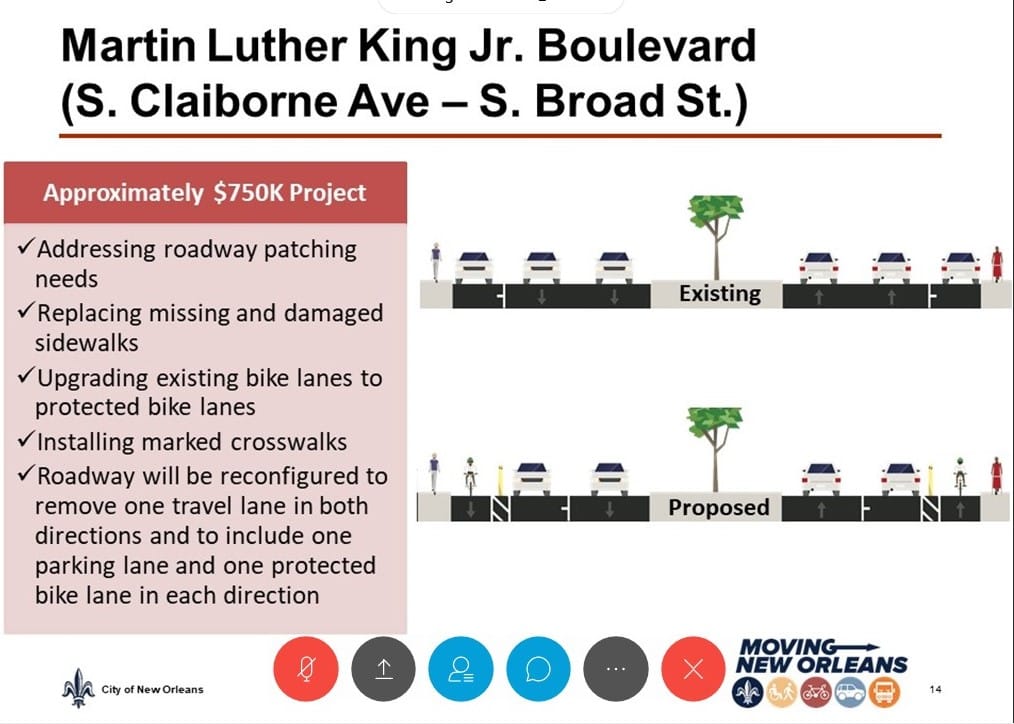
Parking-protected bike lanes and pedestrian crosswalks will transform MLK Jr. Blvd.
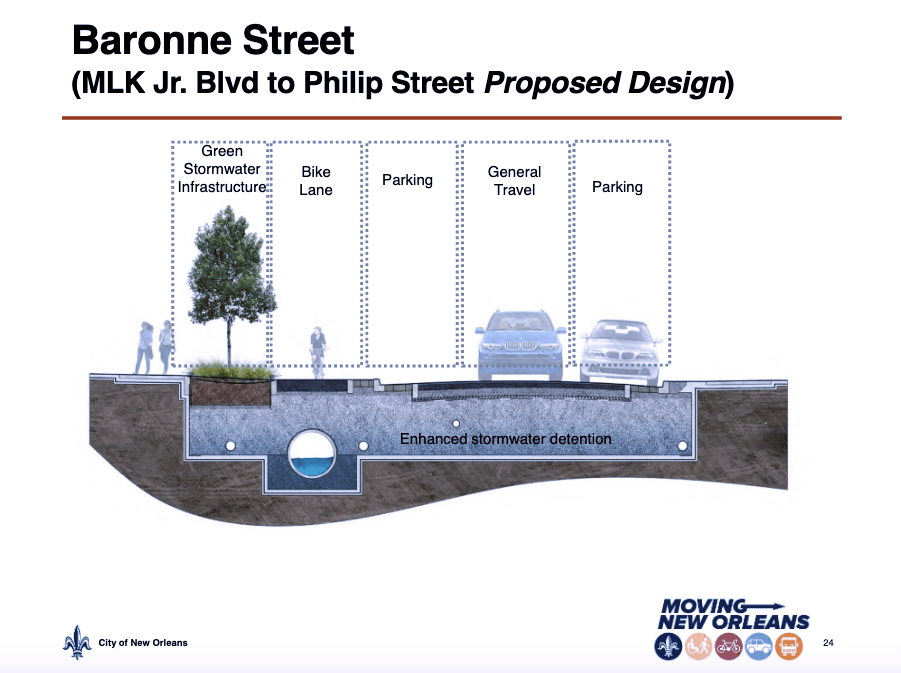
Proposed design for Baronne St. includes a separated and parking-protected bike lane as well as improved green stormwater infrastructure.
BIKE BOXES
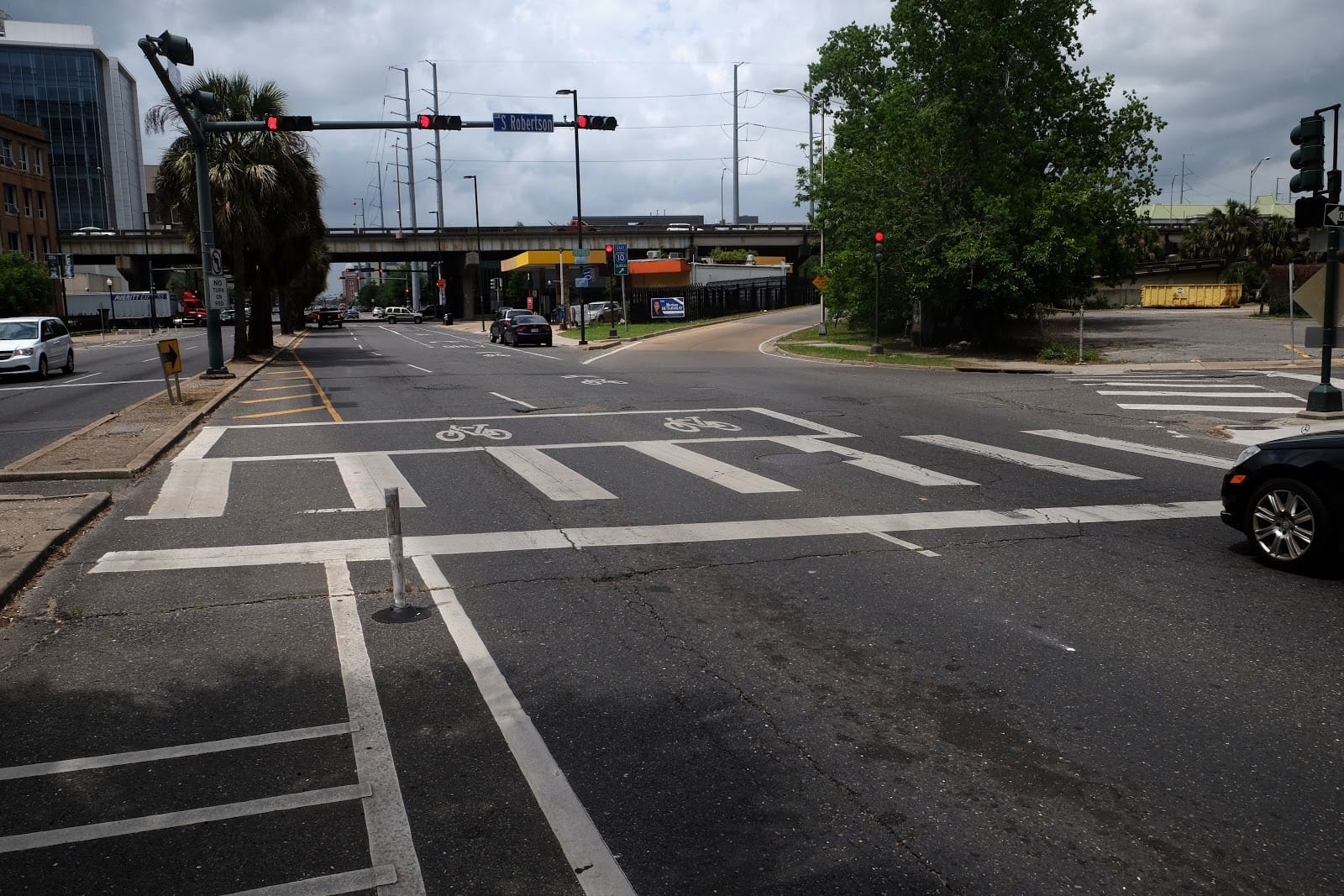
A bike box helps people on bikes move through a tricky intersection with cars entering an on-ramp at Tulane Ave. and N. Robertson.
A “bike box”, also known as an advanced stop line, creates a space for bicycles to stop ahead of cars at intersections with traffic signals. People on bikes are more visible to cars and trucks when positioned in this location. They are less likely to be missed by right-turning vehicles. Research by the Portland State University showed that bike boxes reduced conflict between cyclists and cars, increased yielding behavior, and made both people driving and biking feel safer.

A bike box and marked pedestrian crosswalks are proposed for the intersection at N. Peters and Dumaine St.
What do bike boxes mean for you?
When biking:
Use the box! Position yourself ahead of automobile traffic to get a head start when the light turns green and be visible to the cars directly behind you. Safely make a turn or move ahead to position yourself safely in the lane of traffic on the next block with reduced risk of being cut off by a turning car.
When driving:
At a signalized intersection, stop behind the solid line – don’t block the box! By allowing people on bikes to proceed first, conflicts between people biking and people driving will be greatly reduced.
Be aware – a person biking may start to enter a bike box just as a light changes, yield and give them time to accelerate towards their intended destination of travel. A person biking into the bike box may be hidden from view behind a truck or large vehicle in the right lane.
PAINTED BIKE LANES

The marked crosswalks and green-painted bike lanes help people walking and biking move safely across Broad Street.
According to NACTO, colored pavement within a bicycle lane increases the visibility of the facility, identifies potential areas of conflict, and reinforces priority to bicyclists in conflict areas and in areas with pressure for illegal parking. Benefits of painted lanes include:
- Promotes the multi-modal nature of a corridor.
- Increases the visibility of bicyclists.
- Discourages illegal parking in the bike lane.
- When used in conflict areas, raises motorist and bicyclist awareness to potential areas of conflict.
- Increases bicyclist comfort though clearly delineated space.
- Increases motorist yielding behavior.
- Helps reduce bicycle conflicts with turning motorists.
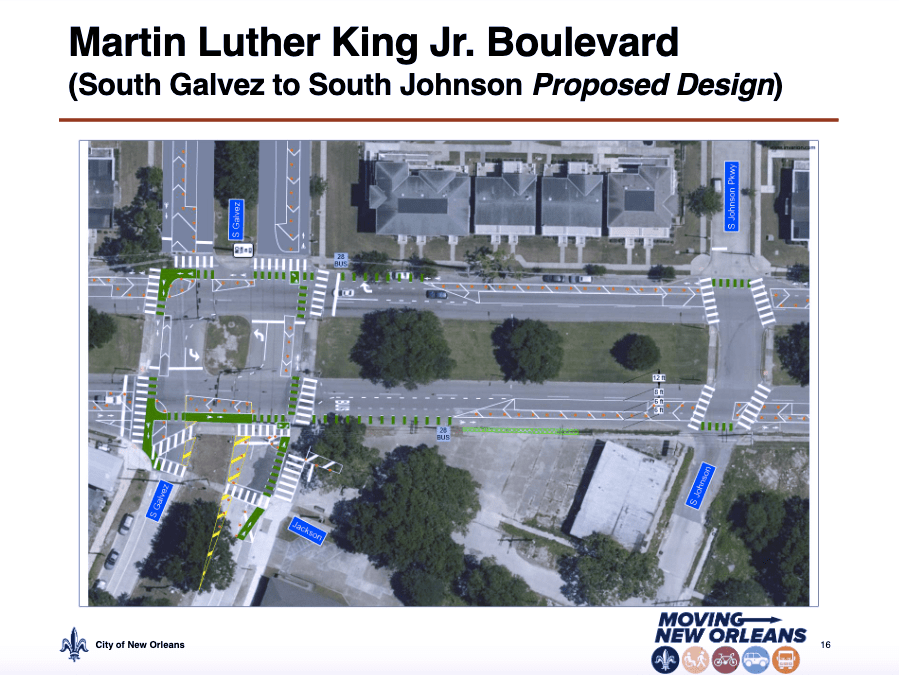
Proposed colored bikes lanes will help people on bikes navigate the intersection of MLK Jr. Blvd. and S. Galvez St.
What do colored bike lanes mean for you?
When biking:
- Roll with greater safety and visibility in your path of travel to other road users.
- Be aware that while colored markings do offer more clarity and awareness, there is not always physical protection and separation offered by protected bike lanes.
- As with other bike lanes, watch for debris and be courteous when sharing the bike lane with others.
When driving:
- Pay attention – colored bike lanes are used to highlight conflict areas. Be aware that people on bikes may be exiting the bike lanes into other lanes of traffic in order to prepare to make a turn. And while the colored paint may end after an intersection, people on bikes are still there!
- Stay out of the bike lane. When driving, pulling over or parking (even if it’s “just for a minute”), make sure to steer clear of the bike lanes. It is illegal to park or drive in a bike lane – these lanes are designated sections of the road for people on bikes to ride safely and freely. Maneuvering out of the bike lane and into the lane of traffic in order to avoid your car can be a tricky and dangerous move for riders. Be cautious, look and yield when crossing a bike lane at an intersection.
Check out the city’s Moving New Orleans Bikes page for more info on planned complete streets improvements coming to the city.
Want to learn more about different types of bike infrastructure? Check out our Virtual Bike Infrastructure Workshop Tuesday, July 28 at 6:00 PM. Click here for more info and to RSVP.
Want to learn more about keeping people on bikes safe while driving? Sign up for our People Friendly Driving Class to learn about common crashes and how to avoid them, safety tips and techniques, and how to navigate bicycle infrastructure on the roadways. Students who complete the class will be awarded a People Friendly Driver Certificate and window decal and become eligible for complimentary Bike Easy membership.
